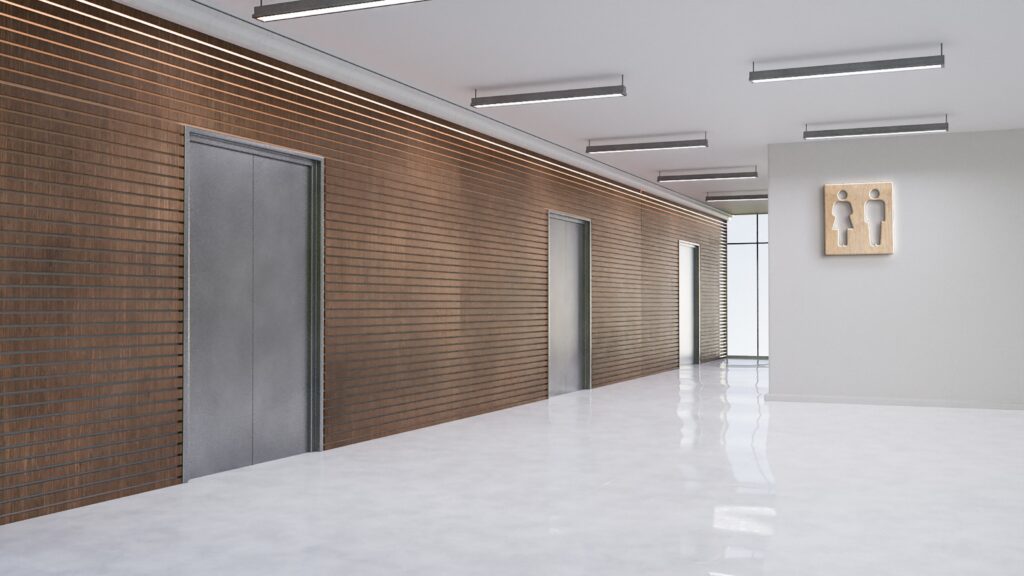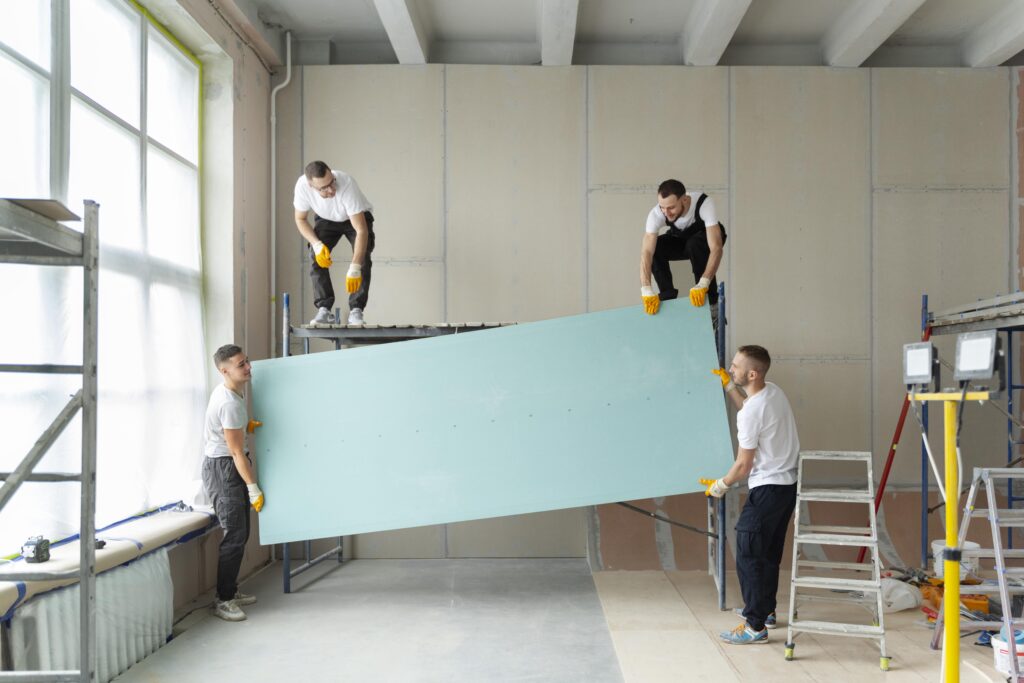Gypsum partition wall have become one of the most popular solutions for dividing spaces in residential, commercial, and industrial settings. Known for their versatility, affordability, and ease of installation, gypsum walls offer a modern alternative to traditional brick or concrete walls. Whether used for creating new rooms, dividing office spaces, or enhancing privacy, gypsum partition walls provide a wide range of benefits while maintaining a sleek, professional appearance.
In this guide, we’ll explore everything you need to know about gypsum partition walls, including their composition, types, installation process, and advantages.
What is a Gypsum Partition Wall?
A gypsum partition wall is a non-load-bearing wall made from gypsum boards, commonly known as drywall or plasterboard, which are mounted on a framework of metal or wooden studs. Gypsum, a naturally occurring mineral composed of calcium sulfate dihydrate, is processed into fine powder, mixed with water, and then compressed between two layers of paper to create gypsum boards. These boards are used to construct interior walls and ceilings.
Gypsum partition walls are widely used in buildings for creating rooms, separating areas, and adding structural flexibility to the interior layout. They are known for their lightweight properties, ease of installation, and ability to achieve smooth, seamless finishes, making them a go-to choice for architects and contractors.

Advantages of Gypsum Partition Wall
Gypsum partition wall offer several advantages over traditional brick or block walls. Here are some key benefits:
a. Quick Installation
Gypsum partition walls can be installed rapidly compared to traditional walls. This is particularly beneficial for projects with tight deadlines, such as office renovations or temporary construction sites. The lightweight materials make handling and installation easy.
b. Cost-Effective
Compared to conventional construction materials, gypsum boards are significantly more affordable. The quick installation process also helps to reduce labor costs, making gypsum partitions a cost-effective solution for interior wall divisions.
c. Fire Resistance
One of the most important benefits of gypsum is its natural fire resistance. Gypsum contains water molecules that are released as steam when exposed to heat, helping to slow down the spread of fire. This makes gypsum partition walls an excellent choice for fire safety in residential and commercial buildings.
d. Sound Insulation
Gypsum partition wall, especially soundproof versions, offer effective sound insulation. They reduce noise transmission between rooms, making them ideal for offices, conference rooms, or residential spaces where privacy and quiet are needed.
e. Lightweight Structure
Gypsum partitions are much lighter than brick or concrete walls. This reduces the load on the building’s foundation and structure, making them suitable for high-rise buildings or spaces where structural load needs to be minimized.
f. Smooth and Aesthetic Finish
Gypsum boards provide a smooth, even surface that is perfect for painting, wallpapering, or applying other finishes. The sleek look of gypsum partitions adds a modern touch to interiors, making them a preferred choice for contemporary design.
g. Environmentally Friendly
Gypsum is a sustainable material that can be recycled. Gypsum boards also have a relatively low environmental impact compared to other construction materials, making them a greener choice for builders and homeowners alike
Types of Gypsum Partition Wall

Gypsum partition walls come in various types depending on the specific application and environment. Each type has unique properties that make it suitable for particular purposes. Here are some of the most common types:
a. Standard Gypsum Partition Wall
This is the most basic and widely used type of gypsum wall. It consists of a single layer of gypsum board attached to a metal or wooden frame. These partitions are ideal for interior spaces that do not require any special features, such as fireproofing or moisture resistance.
b. Moisture-Resistant Gypsum Partition Wall
Moisture-resistant gypsum boards, often called green boards, are treated with special additives to resist water and humidity. These partitions are perfect for bathrooms, kitchens, and other areas exposed to moisture. They prevent mold and mildew growth, ensuring the longevity of the wall.
c. Fire-Resistant Gypsum Partition Wall
Fire-rated gypsum boards are designed with fire retardants to offer extra protection in areas prone to fire hazards, such as kitchens, stairwells, or commercial buildings. These partitions slow down the spread of fire and can contain it for a specified period, helping to protect lives and property.
d. Soundproof Gypsum Partition Wall
For areas where noise reduction is essential, such as conference rooms, recording studios, or bedrooms, soundproof gypsum partitions are used. These walls are made by adding extra layers of gypsum board and insulation materials, such as mineral wool or fiberglass, to enhance sound insulation.
e. Acoustic Gypsum Partition Wall
Designed specifically to reduce noise, acoustic gypsum boards are engineered to absorb sound rather than block it. These partitions are often used in offices, lecture halls, or entertainment spaces where maintaining a quiet environment is essential.
f. Thermal-Insulated Gypsum Partition Wall
In areas requiring temperature control, thermal-insulated gypsum walls can be installed. These partitions are combined with insulation materials to regulate heat flow, keeping spaces cool in summer and warm in winter.

The Installation Process of Gypsum Partition Wall
Installing a gypsum partition wall involves several steps, each contributing to the strength, functionality, and appearance of the wall. The normal installation procedure is summarized as follows:
Step 1: Planning and Measuring
Before installation, the space is measured, and a design layout is prepared. The locations of doors, windows, and any other openings are also considered. This planning stage ensures that the partition wall will meet the functional and aesthetic requirements of the space.
Step 2: Framework Construction
The framework for the partition wall is built using either metal (galvanized steel) or wooden studs. Metal frames are more commonly used for their durability, resistance to corrosion, and ease of installation. The frame is securely attached to the floor, walls, and ceiling using screws or anchors.
Step 3: Cutting and Fixing Gypsum Boards
Gypsum boards are cut to size and fixed onto the framework using drywall screws. Depending on the design, single or double layers of boards may be used. Double-layering provides added strength, fire resistance, and soundproofing.
Step 3: Cutting and Fixing Gypsum Boards
Gypsum boards are cut to size and fixed onto the framework using drywall screws. Depending on the design, single or double layers of boards may be used. Double-layering provides added strength, fire resistance, and soundproofing.
Step 4: Taping and Jointing
Once the gypsum boards are attached, the joints between the boards are sealed using drywall tape and jointing compound. As a result, the surface is seamless and smooth. Multiple coats of jointing compound may be applied, followed by sanding to ensure an even finish.
Step 5: Finishing
After the joints have been sealed and sanded, the wall can be painted, wallpapered, or finished with decorative plaster. The finishing touches ensure the partition wall integrates smoothly with the overall design of the room.
Applications of Gypsum Partition Walls
Gypsum partition wall are used in a wide variety of settings due to their versatility and adaptability:
- Residential Homes: To create room divisions, closets, or home offices.
- Commercial Spaces: For building office cubicles, conference rooms, and reception areas.
- Healthcare Facilities: In hospitals and clinics to create private rooms, consultation areas, and treatment spaces.
- Retail Stores: To create storage rooms, fitting areas, and display sections.
- Hotels and Restaurants: For dividing dining areas, creating guest rooms, or adding decorative elements.
Start with Naseem Decor
For gypsum partition wall work in Sharjah or Dubai, Naseem Decor is a standout choice due to their extensive experience, customized solutions, high-quality materials, and commitment to customer satisfaction. Whether you’re looking to divide spaces in your home, create functional office areas, or enhance your commercial space, Naseem Decor offers reliable and efficient services at competitive prices.

